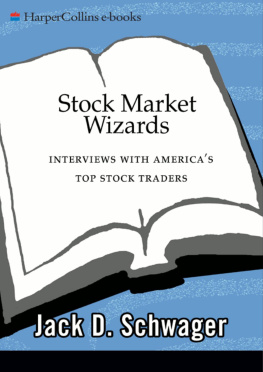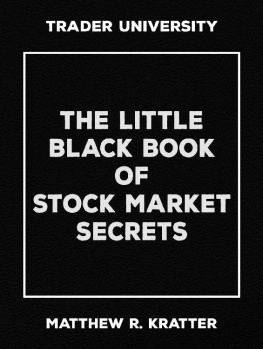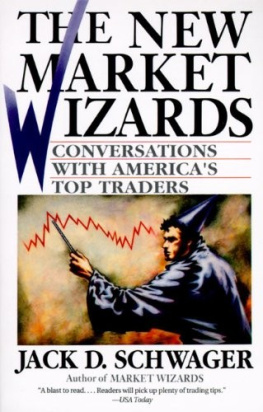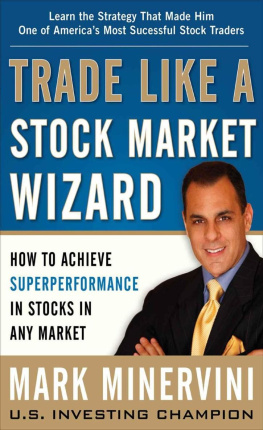Stock Market WIZARDS
Interviews with Americas
Top Stock Traders
Jack D. Schwager

In memory of my mother, Margaret Schwager, loved by all who knew her for her kindness, empathy, and sincerity.
and
In memory of my brother, Kerwin Farkas, deeply loved by family and many friends whose support never waneda reflection of a life well lived.
The interviews for this book were conducted from mid-1999 through early 2000in other words, just before the major top in the stock market (March 2000). Since then, the S&P 500 has been nearly halved, while the Nasdaq has lost nearly three-quarters of its value (as of the end of September 2002).
Thus readers of these interviews are likely to think: Yes, but how have they done lately? Fair question.
In the revised edition, detailed answers to this question have been provided at the end of each chapter, along with short follow-up interviews, focusing on the experience of the traders during this protracted bear market.
Although I found most of the traders in this book through personal contacts in the industry, several money manager databases and texts provided helpful references. In particular, I would cite the following:
Barclay MAP for Windows. This software program, which is updated monthly, allows searches of an impressively large database of hedge fund managers. The program is highly intuitive and permits the investor to extract and rank those trading programs that meet multiple user-defined criteria. (Barclay Trading Group: [641] 472-3456; www. barclaygrp.com .)
Van Hedge Fund Advisors International Inc. (VAN). A hedge fund advisory service that compiles its own hedge fund indexes and maintains one of the largest hedge fund databases. The company provided me with the results of a computer search of hedge fund managers meeting my extremely restrictive set of criteria. ([615] 661-4748; www. hedgefund.com .)
The CTA Report. A quarterly comprehensive compendium of CTA performance results, containing a well-designed two-page layout of tables and charts for each CTA. There is also an easy-to-use Web site for monthly updates. As the name implies, this service covers managers who specialize in futures trading; only a small portion of these managers focus on equity derivatives. (International Traders Research, Inc.: [858] 459-0818; www.managedfutures.com .)
The U.S. Offshore Funds Directory. An annual publication that contains one-page summaries and annual returns for over 700 offshore hedge funds. There is also a web link for updates. ([212] 371-5935; www. hedgefundnews.com )
When I began my search for traders worthy of inclusion in this volume, my first call was to Doug Makepeace. He has built a career on finding and investing his own and client funds with exceptional traders. Doug was most generous in sharing information with me, even though doing so threatened his ability to invest additional funds with these traders in the future if they became too well known.
Tom DeMark, a renowned technical analyst whose indicators are featured on many of the countrys leading financial data services, was particularly vigorous in his efforts to help me find traders for this book. Tom is in a good position to provide such assistance, holding the unofficial world record as the technical analyst who has worked for the most (four) Market Wizards or their organizations.
Marty Schwartz and Linda Raschke were two former Market Wizards (former referring to the books in which their interviews appeared, not their trading talent) who helped me find new Market Wizards for this book.
Other industry contacts who were particularly helpful in aiding my search for great trading talent include: Sol Waksman and George Van; Bob Morris, Andy Good, Tony Cimirusti, Loran Fleckenstein, and Jason Perl.
I find it extremely difficult to evaluate the writing quality of any book I am working on. I lose all sense of perspective. For this reason, it is invaluable to have someone to provide objective feedback as the book is being written. Enter my wife, Jo Ann, who read the final draft of each chapter as soon as it was completed. Her promptness in performing this task was not a reflection of her eagerness to read the materialin fact, few topics interest her less than the financial marketsbut rather a resignation to the inevitable in the face of my unrelenting nagging. (Have you read it yet?) Jo Ann provided honest commentssometimes brutally soand very helpful suggestions, nearly all of which were accepted. Whatever the defects of this book in its final form, I can only assure the reader they would have been that much worse without Jo Anns input.
Men are from Mars because they missed the flight to Venus. When to leave for the airport has always been a subject that my wife and I have viewed from different perspectivesmy view: late enough to make it exciting; my wifes view: early enough to allow for a traffic jam, a flat tire, airport shopping, and a full course meal before the flight.
For years I left for airports without allowing for any spare time and never missed a flight. About eighteen months ago, I moved to Marthas Vineyard, where the travel time to the airport can be accurately estimated because of the limited traffic off-season and because the airport is so smallsort of like the one in the old TV series Wings , only smaller. (At least it was when I began this book; a new airport has since opened.)
One morning, only a few months after we had moved to Marthas Vineyard, my wife, Jo Ann, and I were scheduled to fly to Boston. I was so cocky about the predictability of getting to the airport on time that I left our houseapproximately a twenty-minute drive awayonly thirty-five minutes before the scheduled departure time. The drive took a few minutes longer than expected, due to being stuck behind a slow driver on the no-passing, single-lane road; I realized I had cut it just a little bit too tight.
Well still make it, I assured my wife, but we wont have much extra time. She seemed skepticalirrationally so, I thought. We pulled into the airport entrance only ten minutes before flight time. Even though the parking lot was only a stones throw from the terminal, I dropped Jo Ann at the entrance, saying, Let them know were here.
When I returned about one minute later, I found Jo Ann standing outside waiting for me with a troubled expression. Confused to see her there, I asked, Whats wrong?
The plane left, she said in a voice that was a cross between disappointment and I told you so.
What do you mean, the plane left? I asked, glancing at my watch, even though I knew the exact time. Its only eight minutes to ten.
I went into the terminal, angry that the small prop plane had left without us before the scheduled time. I dont get it, I said to the woman at the airline counter, all prepared to be the aggrieved customer.
She couldnt have been nicer. Our planes leave as soon as everyone is here. Since we hadnt heard from you to tell us you were running late, we assumed you werent coming. If you had called, we would have held the plane. And, you know, they would have, too; thats how Marthas Vineyard works. How could I be angry at anyone other than myself after that explanation?
Fast-forward about six monthsthe beginning of the interview process for this book. I am scheduled to catch the first flight on an intricate itinerary that will take me to four states in four days for six interviews. This schedule has no leeway for missed flights.
Wiser from experience, I make sure to leave early for the airport, allowing for plenty of extra time. On the drive there, Jo Ann, who is dropping me off, notices that I have lint on my blue blazer. She offers the helpful hint that I should ask the people at the airport counter for tape to brush it off. We arrive about thirty minutes early. I pull up to the curb and say good-bye to Jo Ann. After checking in and sitting for a while, I realize I have enough time to take care of my lint-laden jacket. I walk up to the counter and obtain the necessary tape.










